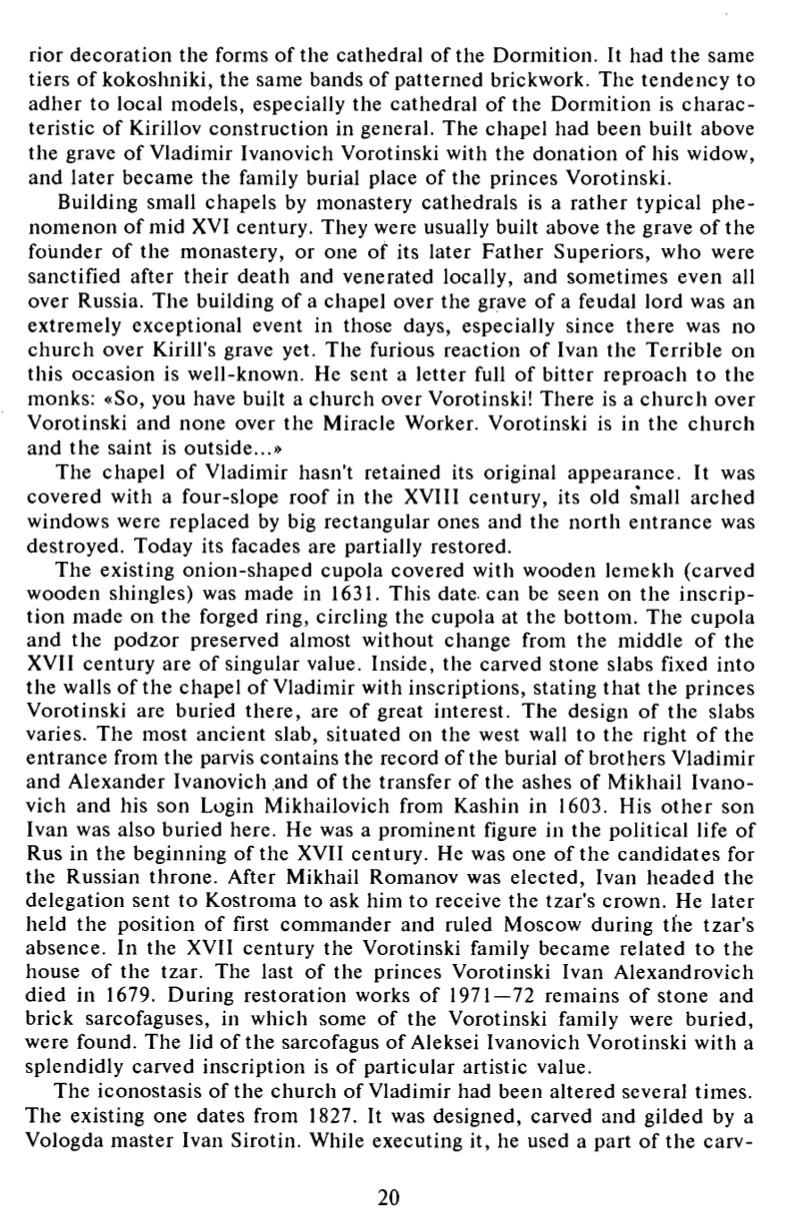

rior decoration the forms of the cathedral of the Dormition. It had the same
tiers of kokoshniki, the same bands of patterned brickwork. The tendency to
adher to local models, especially the cathedral of the Do rm ition is c h a r a c
teristic o f Kirillov construction in general. The chapel had been built above
the grave o f Vladimir Ivanovich Vorotinski with the donation o f his widow,
and later became the family burial place of the princes Vorotinski.
Building small chapels by monastery cathedrals is a rathe r typical p h e
nomenon o f mid XVI century. They were usually built above the grave o f the
founder o f the monastery, or one o f its later Father Superiors, who were
sanctified after their death and venerated locally, and sometimes even all
over Russia. The building o f a chapel over the grave o f a feudal lord was an
extremely exceptional event in those days, especially since there was no
chu rch over Kirill's grave yet. The furious reaction o f Ivan the Terrible on
this occasion is well-known. He sent a letter full o f bitter reproach to the
monks: «So, you have built a church over Vorotinski! There is a chu rch over
Vorotinski and none over the Miracle Worker. Vorotinski is in the chu rch
and the saint is outside...»
The chapel o f Vladimir hasn't retained its original appearance. It was
covered with a four-slope roof in the XVIII century, its old small arched
windows were replaced by big rectangular ones and the no rth en trance was
destroyed. Today its facades are partially restored.
The existing on ion-shaped cupola covered with wooden lemekh (carved
wooden shingles) was made in 1631. This date, can be seen on the in sc r ip
tion made on the forged ring, circling the cupola at the bottom. The cupola
and the podzor preserved almost without change from the middle o f the
XVII century are of singular value. Inside, the carved stone slabs fixed into
the walls o f the chapel o f Vladimir with inscriptions, stating tha t the princes
Vorotinski are buried there, are o f great interest. The design o f the slabs
varies. The most ancient slab, situated on the west wall to the right o f the
en trance from the parvis contains the record of the burial of brothers Vladimir
and Alexander Ivanovich and of the transfer o f the ashes o f Mikhail Ivano
vich and his son Login Mikhailovich from Kashin in 1603. His o th e r son
Ivan was also buried here. He was a prominent figure in the political life of
Rus in the beginning of the XVII century. He was one o f the cand ida tes for
the Russian throne. After Mikhail Romanov was elected, Ivan headed the
delegation sent to Kostroma to ask him to receive the tzar's crown. He later
held the position o f first commander and ruled Moscow during the tzar's
absence. In the XVII century the Vorotinski family became related to the
house o f the tzar. The last o f the princes Vorotinski Ivan Alexandrovich
died in 1679. During restoration works o f 1971—72 remains o f stone and
brick sarcofaguses, in which some of the Vorotinski family were buried,
were found. The lid o f the sarcofagus of Aleksei Ivanovich Vorotinski with a
splendidly carved inscription is o f particular artistic value.
The iconostasis of the chu rch of Vladimir had been altered several times.
The existing one dates from 1827. It was designed, carved and gilded by a
Vologda master Ivan Sirotin. While executing it, he used a part o f the ca rv
20















